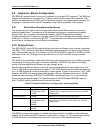
Intel® Server Board SE7501WV2 TPS BIOS
Revision 1.0
Intel reference number C25653-001
79
6.12.2 Advanced Configuration and Power Interface (ACPI)
The primary role of the ACPI BIOS is to supply the ACPI Tables. POST creates the ACPI
Tables and locates them above 1 MB in extended memory. The location of these tables is
conveyed to the ACPI-aware operating system through a series of tables located throughout
memory. The format and location of these tables is documented in the publicly available ACPI
specification. To prevent conflicts with a non-ACPI-aware operating system, the memory used
for the ACPI Tables is marked as “reserved” in the INT 15h, function E820h.
As described in the ACPI specification, an ACPI-aware operating system generates an SMI to
request that the system be switched into ACPI mode. The BIOS responds by setting up all
system (chipset) specific configuration required to support ACPI, issues the appropriate
command to the BMC to enable ACPI mode and sets the SCI_EN bit as defined by the ACPI
specification. The system automatically returns to legacy mode on hard reset or power-on reset.
There are three runtime components to ACPI:
• ACPI Tables: These tables describe the interfaces to the hardware. ACPI Tables can
make use of a p-code type of language, the interpretation of which is performed by the
operating system. The operating system contains and uses an AML (ACPI Machine
Language) interpreter that executes procedures encoded in AML and stored in the ACPI
Tables; ACPI Machine Language is a compact, tokenized, abstract machine language.
The tables contain information about power management capabilities of the system,
APICs, and the bus structure. The tables also describe control methods that the
operating system uses to change PCI interrupt routing, control legacy devices in Super
I/O, and find the cause of wake events.
• ACPI Registers: ACPI registers are the constrained part of the hardware interface,
described (at least in location) by the ACPI Tables.
• ACPI BIOS: This code boots the machine and implements interfaces for sleep, wake,
and some restart operations. The ACPI BIOS also provides the ACPI Description
Tables.
All IA-32 server platforms support S0, S4, and S5 states. The SE7501WV2 server board also
supports the S1 state. S1 and S4 are considered sleep states. The ACPI specification defines
the sleep states and requires the system to support at least one of them.
While entering the S4 state, the operating system saves the context to the disk and most of the
system is powered off. The system can wake from such a state on various inputs depending on
the hardware. The SE7501WV2 platform will wake on a power button press, or a signal received
from a wake-on-LAN compliant LAN card (or on-board LAN), modem ring, PCI power
management interrupt, or RTC alarm. The BIOS performs a complete POST upon a wake from
S4 and initializes the platform. S4BIOS is not supported.
The SE7501WV2 server board can wake from the S1 state using a PS/2 keyboard, mouse, and
USB device in addition to the sources described above.
The wake sources are enabled by the ACPI operating systems with co-operation from the
drivers; the BIOS has no direct control over the wake sources when an ACPI operating system
is loaded. The role of the BIOS is limited to describing the wake sources to the operating
system and controlling secondary control/status bits via a Differentiated System Description
Table (DSDT).


















